Text
Table-ronde: musiques des Caraibes


1 note
·
View note
Text
Expo et conference du 4 au 25 mai 2024
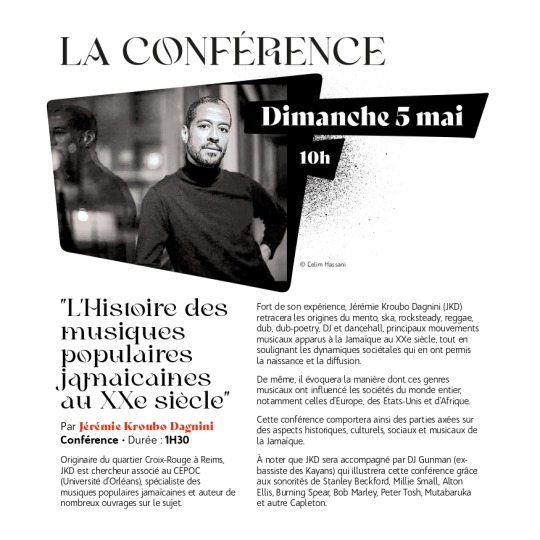
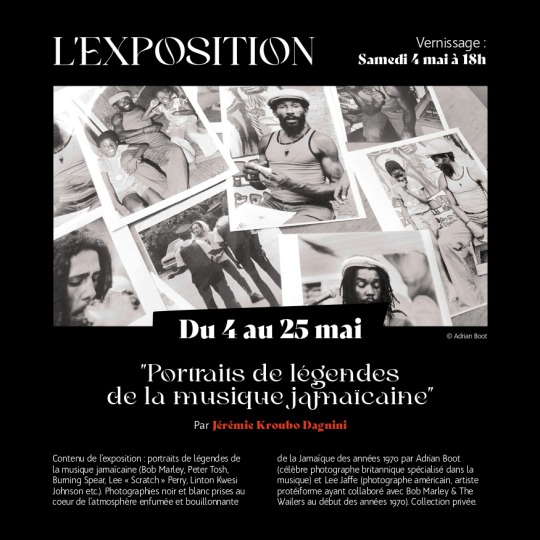
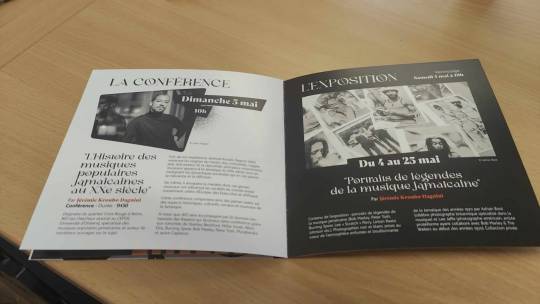
Lieu:
L'espace le Flambeau
13 Rue de Bétheny, 51100 Reims
03 26 07 28 21
0 notes
Text

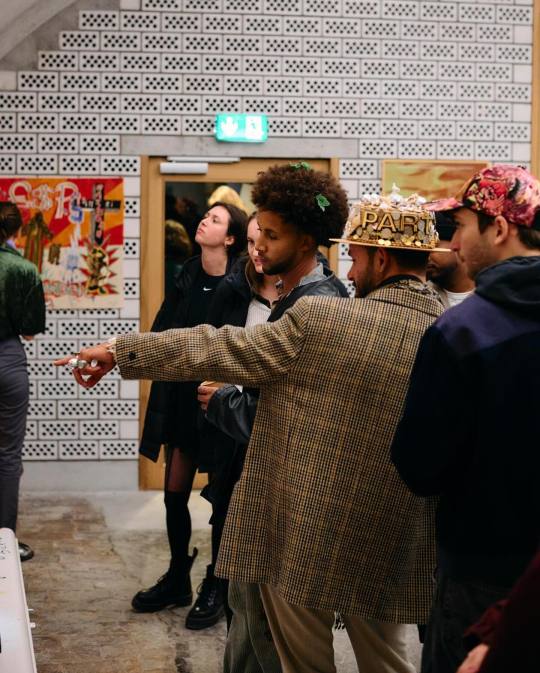

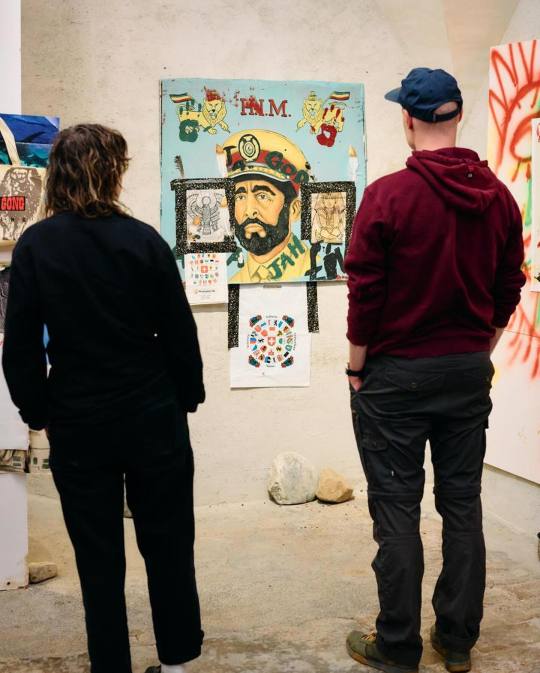


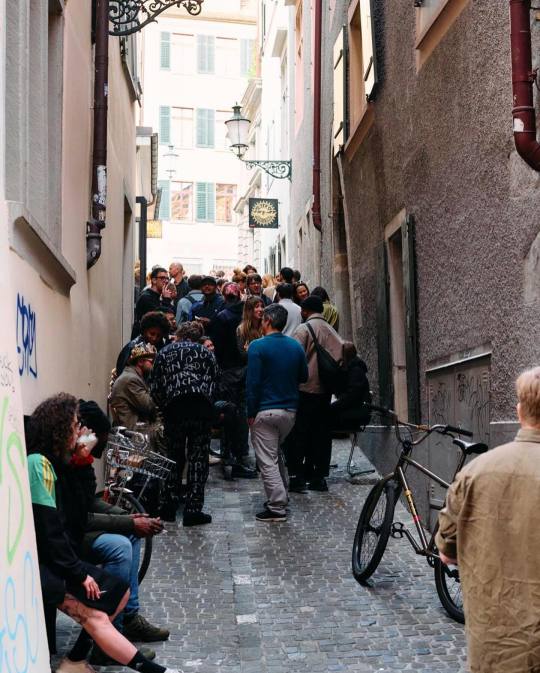
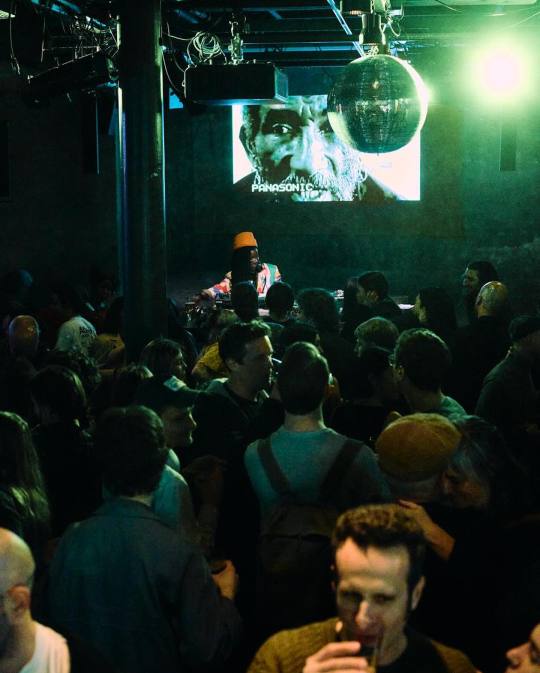
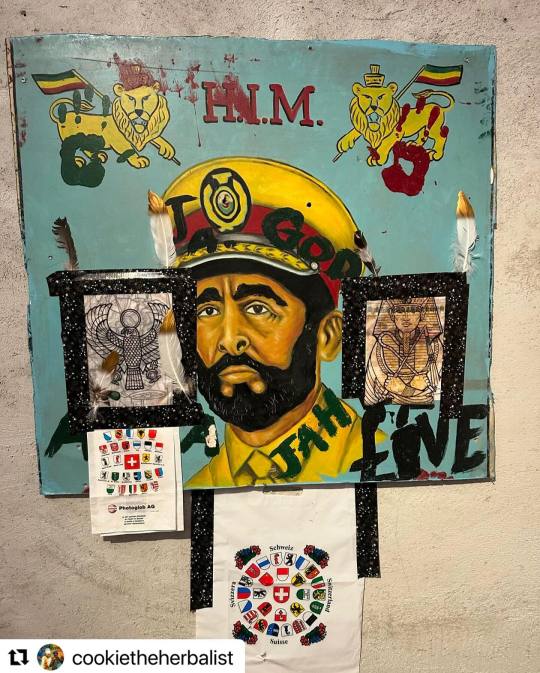
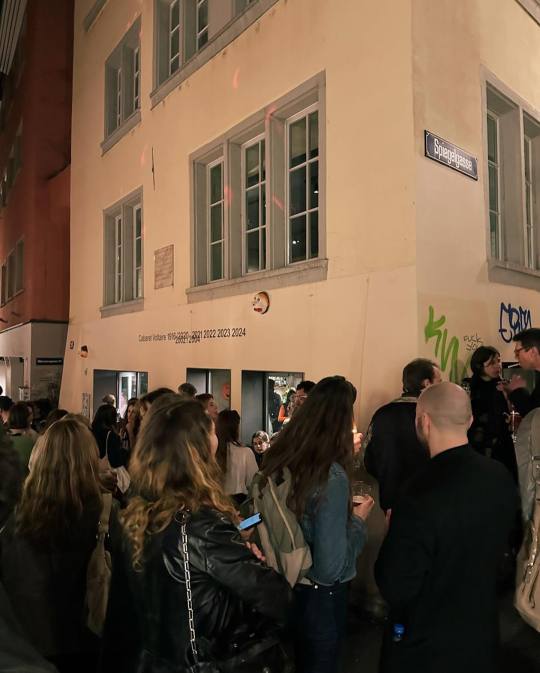
Lee Scratch Perry's first institutional solo exhibition in Switzerland and Europe opens at Cabaret Voltaire on April 11. The exhibition will be on display in the Vaulted Cellar from April 12 to September 29.
Opening hours Exhibitions and Library:
Tue and Thu, 13:30–20:00
Wed, Fr and Sa, 13:30–18:00
Sun, 13:30–18:00
Opening hours Bar and Café:
Tue–Thu, 13:30–24:00
Fr–Sa, 13:30–02:00
Sun, 13:30–18:00
Cabaret Voltaire
Spiegelgasse 1
8001 Zürich
Office: +41 43 268 08 44
[email protected]

0 notes
Text
LEE SCRATCH PERRY FIRST INSTITUTIONAL SOLO EXHIBITION
Lee Scratch Perry's first institutional solo exhibition in Switzerland and Europe opens at Cabaret Voltaire on April 11. The exhibition will be on display in the Vaulted Cellar from April 12 to September 29.
Program opening (11 April 2024):
18:00 – Opening of the exhibition
19:00 – Welcome and introduction by Salome Hohl and Visual Estate of Lee Scratch Perry
21:00 – DJ set Mother Dubber (Trinity Njume-Ebong)

For further info: https://www.cabaretvoltaire.ch/en/programme/opening-lee-scratch-perry#node-94758-en
0 notes
Text
1ERE EXPOSITION INSTITUTIONNELLE PERSONNELLE DE LEE SCRATCH PERRY EN EUROPE
Pour plus d'informations:
A lire l'article très complet publié sur Reggae.fr: https://reggae.fr/lire-news/22475_202404_1ere-expo-institutionnelle-personnelle-de-Lee-Perry-en-Europe.html
Exposition du 12 avril au 29 septembre 2024.
Cabaret Voltaire
Spiegelgasse 1
8001 Zürich
Téléphone : +41 43 268 08 44
[email protected]
https://www.cabaretvoltaire.ch/
https://www.leescratchperry.art/
https://suns.works/
http://www.leescratchperry-peterharris-art.com/
0 notes
Text
JAH PRINCE AU NEW MORNING LE 19 JUIN 2024
« L’Etat de Côte d’Ivoire m’a expulsé vers l’Europe et interdit du territoire ivoirien pendant 5 ans. En général, ce sont les Noirs qui sont rapatriés vers l’Afrique, mais un Africain noir rapatrié vers la France, des Africains qui rejettent leur frère, c’est la pire des choses que j’ai vu depuis que je suis sur Terre. C’est la première fois que je vois un Noir rejeter de l’Afrique vers l’Europe » (Jah Prince au micro de Radio France).
En tant que chercheur, spécialiste de la musique jamaïcaine et d’origine ivoirienne de surcroît, il me semble important, pour ne pas dire indispensable d’apporter ma pierre à l’édifice pour que la vie de Jah Prince gagne en prospérité et stabilité et, pourquoi pas, pour que cet artiste devenu SDF au Bois de Vincennes renoue avec un certain succès.
D’où ce petit article qui, je l’espère, contribuera à mettre en lumière cet artiste singulier, écorché, au parcours atypique et quelque-peu chaotique.
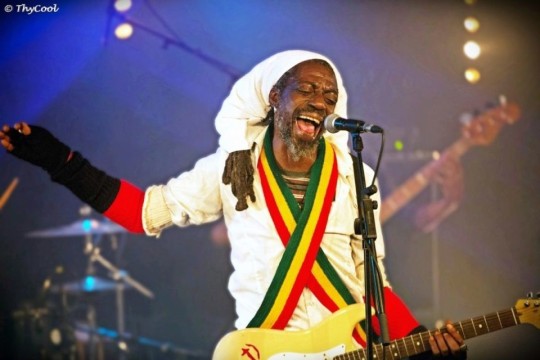
youtube
Pour découvrir le parcours atypique de Jah Prince (écouter 30 min le podcast ci-dessous) :
Pour plus d’infos sur son concert au New Morning du 19 juin : https://www.newmorning.com/20240619-5963-jah-prince-the-prophets.html
Pour écouter l’album de Jah Prince & The Prophets, Prisonniers de Babylone : https://music.imusician.pro/a/_1xdJfbv
Site officiel de Jah Prince : https://jahprince.fr/
Copyright JKD.
0 notes
Text
INSIDE THE ARCHIVES: AN INTERVIEW WITH HERBIE MILLER
Out of my personal archives here is an interview I conducted with Herbie Miller – current Director/ Curator of the Jamaican Music Museum (JaMM) – on 27 November 2006. If my memory serves me well, I had been introduced to Herbie Miller a few days before by the late Professor Alston “Barry” Chevannes, sociologist and authority on Rastafari. When I met Herbie, he was completing his PhD in cultural studies at the University of the West Indies (UWI), Mona, Jamaica. His doctoral research dealt with Jamaican ska trombonist Don Drummond. Some excerpts of this interview appear in my book, Vibrations jamaïcaines (French language), but it has never been fully published until now. So, fasten your seatbelt and let’s dive into this deep conversation dealing with various topics of interest such as Bob Marley, Peter Tosh, Bunny Wailer, Rastafari, Mortimo Planno, Jamaican politics, the unsolved assassination attempt on Bob Marley, the evolution of Jamaican music and the Rolling Stones among others.

Herbie Miller and me in his office at UWI, 27 November 2006. © JKD
JKD: Hi Herbie, nice to meet you!
Herbie Miller: Nice to meet you Jeremie.
First of all, can you just introduce yourself and tell me the position you hold here at UWI?
Well, I’m Herbie Miller. My position here is in the capacity of completing my own PhD in cultural studies. At present I’m a…God what they call it? There’s a word in some sort of Department, something I am, at this point I’m not even sure of what it is! (Laughs)
(Laughs). I heard that you used to be the manager of Peter Tosh. When exactly?
I managed Peter when he embarked in a sort of career from 1976 to about 1982-83.
Right. You know, Bob Marley, Peter Tosh and Bunny Wailer were friends but had a different personality. Can you tell me the main characteristics of each person and how they differed from each other?
Well, of course, you can see in both Marley’s work and his personality that he was really a thinking musician. He brought a lot of militancy and spirituality to his music. At the same time, he was quite outgoing, he was also quite reclusive. It all depended on what the situation was. He was outgoing in the sense that he went to public events, especially soccer. He went to night clubs and stuff like that. He was private in the sense that, to a great extent, Bob was very withdrawn and shy, I could say. He was quite aware of his stature and who he was and as a result he understood that in many ways he had to secure that self. He couldn’t just go out there as the average citizen. So in that respect he understood his position, his place and guarded it to some extent. Peter, on the other hand, was totally outgoing in every way. Peter was the type of person who went to football games and sport events as Bob and Bunny would. But he was outgoing in that he was a man of the streets. He was not shy, he would talk to people. His personality is perceived as one that is quite extremely militant if not revolutionary. To some, he was angry, to others he was jovial, critical, sensitive, generous, humorous, funny as hell, quite a complex personality Peter was. Bunny is perhaps the more reclusive, remains the more reclusive as a matter of fact [Editor’s note: Bunny Wailer was still alive at the time of the interview in 2006]. As all the fans know, Bunny was the first to give up being a fulltime public figure. He recorded, he was a great soccer player, he has his own community of followers and community in which he’s very relaxed. He was at the same time guarded and it’s perhaps to the extent that he has survived. So, three different types of videos. Get together the main one great if not the greatest unity as a single voice.
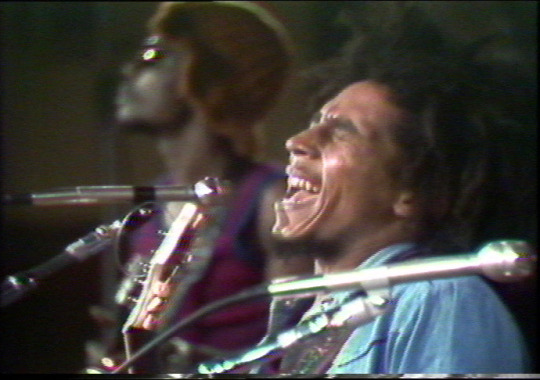
Bob Marley and Peter Tosh at Capital Records, 24 October 1973. © Screenshot from a film directed by Lee Jaffe and Leon Russell
Did they turn to the Rastafari faith at the same time?
I think they all of them embarked on the tradition and self discovery at about the same time. Bunny might have been ahead of Bob and Peter in that respect but I’m not sure. The biographies are out there, the biographic videos are out there, the testaments are out there, I wasn’t that close to know but I do know that all three of them defended the Rastafari faith strongly.
And were the three of them followers of Planno or was Bob Marley the only one?
I think all three embarked on the tradition under Planno’s guidance. I think Bob stick with it and maintains his close relationship to Planno the longest.
Then the relationship between Planno and Marley broke up at some point. Do you know why?
I haven’t a clue. I don’t know about that, no!
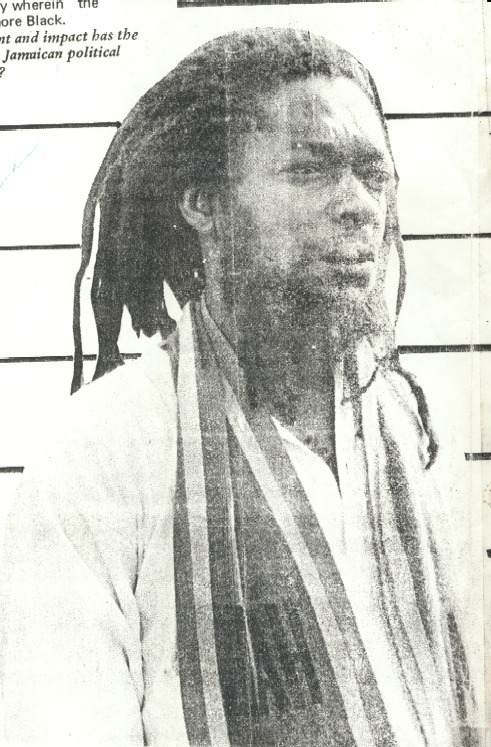
Mortimer Planno in Lagos (Nigeria), July 1979. © Tam Fiofori
So how do you explain that Bunny Wailer and Peter Tosh decided to quit the band after the second album?
Do I have to explain that? They have explained it over and over themselves. There are lots of interviews with Peter where he explains it. You know, Peter basically felt that the three of them were strong in the videos, correctly so. He also knew that as a group they were extremely strong but that the focus on the group had become the focus on Bob Marley. And Peter felt that he needed his own attention. In fact, Peter was the first of the three of them to record solo. He always recorded as Peter Tosh and he always recorded as a part of the Wailers. And it was not put any hard feeling that Peter decided to go on his own. Bunny, on the other hand, had philosophical reasons why he decided to quit. He just thought that he was up to the heavy tour and schedule and at some point felt uncomfortable with some of the places in which they had to perform.
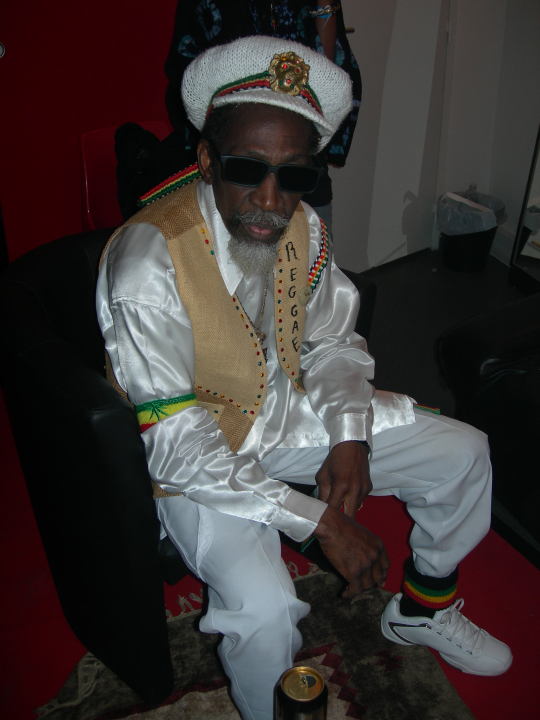
Bunny Wailer backstage at the Zénith Paris, 21 April 2007. © JKD
Do you think that in the 70s, politicians tried in a way to co-opt the Rasta movement and reggae singers?
By the 70s, Rastafari was going through and had gone through a series of oppression on behalf of different governments. And so by the early 70s, with the wind of change blowing in the air, of course it was an advantage for politicians to give some sort of recognition to Rastas; perhaps just stopping short of making the grand promises. And certainly with the closeness to the musicians, and the music, and the people that the politicians had at that point, particularly the PNP, they saw they could really utilize musicians and securing votes. And certainly the musicians reacted to it positively; they participated in political band wagons around the country. That featured some of the best artists of the moment.
"to the vast amount of poor people and sufferers and roots people and Rasta people and African-Jamaican-Black people down there on the ground nothing supersedes the Wailers"
And what was Peter Tosh’s point of view on this situation? Was he cautious regarding the links between politics and artists?
I think the fact that they performed for a particular party reveals a particular mindset or way of thinking or direction in which they thought the politics should head. So by the mere fact that they participated, you know, cautious in the fact that we all are cautious around election time to the extent that we are involved with it or not involved with it, but everybody gets cautious at that time. And so I imagine that, yes, they were cautious, but at the same time they thought that change was necessary and that they could provide people with a direction if they identify with a particular party and what direction that party could head.
You know, Bob Marley was about to be killed at the time of the Smile Jamaica concert. Do you think that there are some links between the election and this assassination attempt?
Of course the world of the streets is of such. The official opinion is that the verdict is still out. You know, it’s one of those things that happened. It’s in the past. It might not be totally settled in terms of who did what? Who sent whom? And so on. I certainly am not private to that information if it is, if it has been declared.

In the late 70s some say that the Wailers were more popular in Europe than in Jamaica. Is it true and if so, do you know why?
It depends on which Jamaica you are talking about! The Wailers have always been popular among a certain group of Jamaicans.
Which group?
The people, people of the streets. They have always been popular whether or not they were played on the radio or they were performing live or even if they were recording at all. The Wailers was the people’s group above every other group. By none! The people who they became popular to later on are those who initially rejected them, who had no use for them, no use for them until the same people talk about them in Europe and abroad accepted them; and say look “This is great!” Then these other set a folks basically up the band wagon. But the Wailers were never unpopular, never unpopular. No, they might not have been in the charts at a given time as others were and among a certain middle-class or elite, but to the vast amount of poor people and sufferers and roots people and Rasta people and African-Jamaican-Black people down there on the ground nothing supersedes the Wailers, none, at any given time.
What’s your general opinion on the evolution of Jamaican music and the new generation of artists?
I think that good things are happening, lots of great things are happening. Jamaican music has never been more internationally popular, meaning to say bursting into the charts, making waves on big radio stations, popping up outside of just the narrow so-called reggae category in the Grammys and all over. Jamaica is attracting musicians of all sorts coming into mix and deal with the music on the new level. They have always come, from the days of ska they have been coming but today it might be commercially much more popular than it ever was. Qualitatively speaking, the tourist is out, ska was not but “boogooyaga” music to the same people who later on embraced the culture because they control the airwaves, they control the newspaper, they control the print, they control everything. And Jamaican culture to them was not reflected in Rasta people and local aesthetics. It was reflected in a Euro-centric foreign taste across the board: clothes, food, music, whatever. To the poors, that be that’s what counted. From ska to rocksteady we still had visitors coming to the island, Paul Simon, Herbie Mann, Aretha Franklin etc. Reggae: Barbra Streisand, Joe Cocker, Eric Clapton, Taj Mahal and this goes on. And today with a new breed of music makers and music appreciators, they have hip-hop and rap and dancehall reggae. And those are the people; that’s happening today. The same people ant the same set of folks in the same Jamaican society are calling everything else but artists. That put them down, they say “this the sing, talk, chat, slackness and so on”. I don’t know, I don’t even understand some of what them say, all I know is the beat to most of the song really grab you. And if the beat grabs you at some points you try to figure out if you’re dancing to youth calamity or you’re dancing to glory. You know, young guys such as yourself, I’m sure, can relate to what’s going on, especially if you bash down class and race and barriers such as those that prevent people from all heartily accepting change. Because this really is changing, nothing stands still! Rock time music turning to boogie-woogie music turning to big band music, turning to bebop music turning to hard bop, along the way are the way up to the 60s, Coltrane and Ernest Goodman, at every point of that change there were people critics and some musicians who say that is crap. Louis Armstrong called Dizzy Gillespie Chinese music. So we’ll never get rid of that! Some classic reggae artist from the 70s, I’m sure, are calling this music trash. We don’t know, I don’t know! I am waiting to see out. But I know there are lots of good things out there.
But it seems that artists from the 70s like Max Romeo or the Gladiators are more popular in Europe than in Jamaica today. Why according to you?
That’s not a strange thing, you know? In Europe, 1960 soul artists are still making headline gigs. At home, they stay at home and watch TV. Nobody cares about them at home in America. I remember when…what’s his name again? He was doing in New Orleans a song called “Get Out of My Life, Woman,” I think Dorsey was his last name.
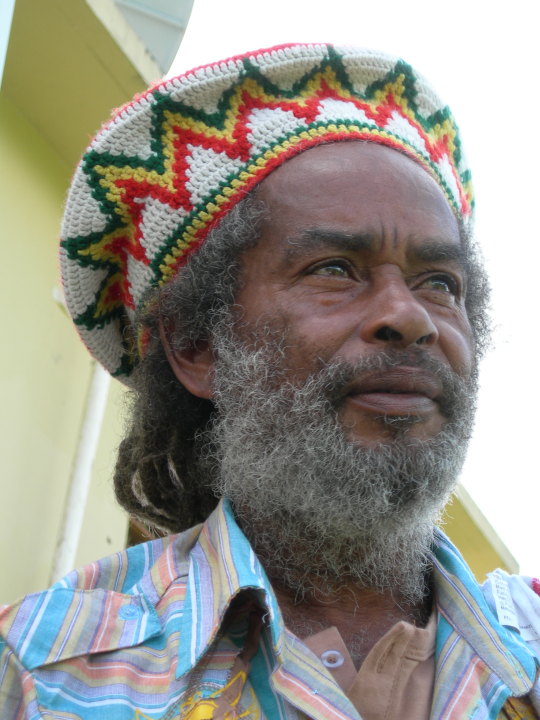
Max Romeo at home (Linstead, Jamaica), 21 November 2006. © JKD
Lee Dorsey?
Yes, that’s it, Lee Dorsey. He was a mechanic in America but a headline in Europe. Lee Dorsey was his name, a headline in Europe but a mechanic in New Orleans, who cares? Blues singers were the same, they could make a big gig over in England, Muddy Waters, Howlin’ Wolf,all of them, but in America nobody really cares. It’s the same thing with the reggae thing. Nobody cares about Burning Spear performing down the year, Jimmy Cliff just performed for the first time in many years. Most of these great artists in spite of…you see here is the cutting edge place, this is where the new trends take place. They establish things with a firm whole, they are over in Japan, they are over in Africa, they are in Europe, in South America, the classic guy that’s where they are. Soon or later, Buju, Capleton, Bushman, Sizzla, those I think are some of the stronger ones today. Certainly, in my estimation, they will become classic performers and whatever will replace them, somebody will be asking “You think that this music is as good as dancehall music?” “How come dancehall artists are not performing in Jamaica any more but only in these other places?” And that what will happen like everything else! Things change but there are all just ska children.
I’d like to have your opinion on another topic. You know, lots of artists sing about Africa and the back-to-Africa movement, but it seems that actually just a few of them truly go to Africa.
I think the song of Africa that comes out of reggae artists and that comes out in reggae songs is a way to deal with the fact that we, in Jamaica, especially those of us influenced by Rastafari’s thinking and Marcus Garvey’s thinking, have always seen Africa as the original homeland. I don’t think it’s so much that any of them necessarily have to or perhaps even want to live in Africa. I think they live in Africa inside of their heads. Once you can come to grips with the idea that they are sons and daughters of Africa, I think the level of comfort is a relaxed one. The tension arises when they can’t figure out who they are. The fact is that they are Jamaicans. The world view of that particular Jamaica is that is in Africa, not necessarily living in Africa or having to live there. They sing about it, about the past, the history and when Burning Spear says “Do you remember the days of slavery,” Spear isn’t asking as if to say “he read about it or heard about it,” he asks that question in such a way as if to say “I remember because I was there” and when he asks he wants you and us to remember as if we were also there because the fact is that we were there. So this is a sort of cultural, historic memory, a sort of collective memory if you will that allows that sort of language to emerge. Not I was told about it or I learnt about it or I read about it but I remember it! When Third World say “96 degrees in the shade” it’s like they know what they are talking about. They didn’t learn that in school and so on. Hence the relationship to Africa and colonization is a mental thing, you’re decolonising your mind and set yourself free. Marley said in “Redemption Song” “Emancipate yourself from mental slavery/ None but ourselves can free our mind.” So those are profound philosophical reasonings to deal with that situation. And that’s why they sing so much about it. Whether or not they go to Africa to perform is based on the fact that if you get invited to go perform somewhere you go. But artists don’t pick up themselves and just say “I want to go perform in Europe….” And of course Africa isn’t set up like that. The rest of Europe is perhaps set up and you can just pick up the phone and book an agent and blah blah blah. Probably where in Europe some African companies say “Man come play in my town…”..there is no big organized music industry in Africa to deal with it the way we deal in Latin America and Europe and Japan. Everywhere else you take a chance as long as you go. You feel it and for better or for worst you deal with it.
So I’d like to conclude this interview with a few questions on Peter Tosh. First, when you toured with the Rolling Stones, did they get along together?
They got along great, you know, they really got along fine. They were a bunch of crazy guys the Stones and… We toured together, we worked together, Peter was signed to their label, we ate together, we did things together… You know, the Stones basically brought Peter internationally so we had to be close. And that just came about because they wanted to sign Peter when he was available for signing at the end of his contract with CBS Records, now Sony Music. And they expressed that opinion through a mutual friend that Sony had. We negotiated to do them and I made the deal.
When did you tour exactly?
It was in the late 70s I believe. It was the year Mystic Man came out. I think it was around 77-79.
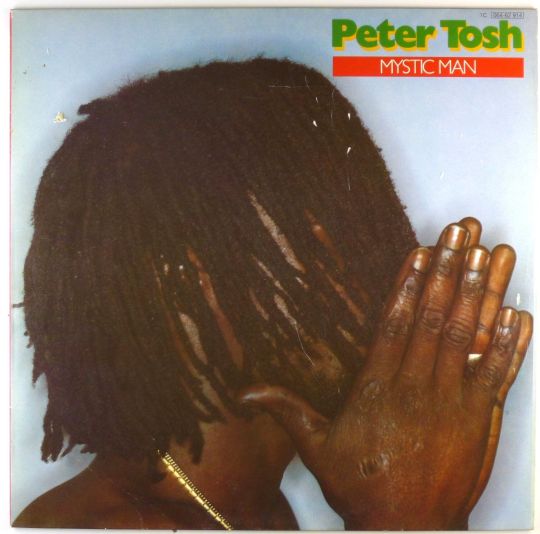
© Peter Tosh, Mystic Man, 1979, Rolling Stones Records - 1C 064-62 914
So it was good times?
It was real good times. It was a time when you could see growth, you could see the things moving from point A onwards, growth was visible.
And the Stones came to Jamaica?
Oh Yes. In fact, I think Keith had a place here and he still comes here. He came just to chill out and hang out with Peter and stuff like that.
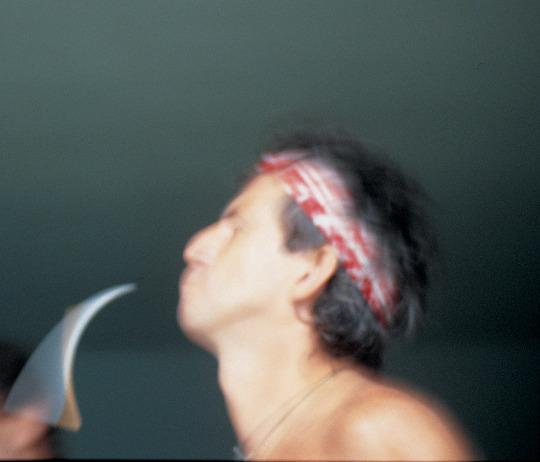
Keith Richards, Ocho Rios. © Lee Jaffe
Peter was as you said very radical and he also used to criticize the Establishment openly and stuff like that. Do you think that he might have been assassinated because of that?
Many theories fly around. I myself was not involved with Peter at the time that happened, unfortunately. It was an unfortunate incident. I don’t know what was happening with his new management people. What I do know is that there was some sort of stand off, he wasn’t recording, he wasn’t touring. They obviously wanted him to record and tour. I know that there was some sort of lawsuit that apparently he won. People demanded money at his house and…perhaps it was just a robbery. I’ve heard assassination theories, I’ve heard the government theories, I’ve heard the drugs theories that one I can without any doubt tell you Peter would not be involved with. Peter smoked weed, that’s it! Nothing else. He doesn’t sell it. He gives it away. He doesn’t trade in it and as far as I know, as long as I was with him, I have nothing to do with people who were involved that way. So all these arguments about Peter both somebody taking a rob from Peter, I don’t buy that.
My last question deals with his famous M16 guitar for sale on eBay [Editor’s note: in November 2006, Peter Tosh’s M16 rifle-shaped guitar had been posted on Internet auction site eBay before being called off]. May I have your point of view on that?
You can read my point of view, it came out, it was the second article about it in the Jamaica Observer. If you read this second piece which came out in the Jamaica Observer, some two weeks ago, you’ll see exactly how I feel about it.
You feel sad I suppose?
More than sad, I feel totally upset. When you’ll read it you’ll see exactly how I feel. Read it! (Laughs).
Thank you for your time Herbie.
You’re welcome Jeremie. You’re welcome.
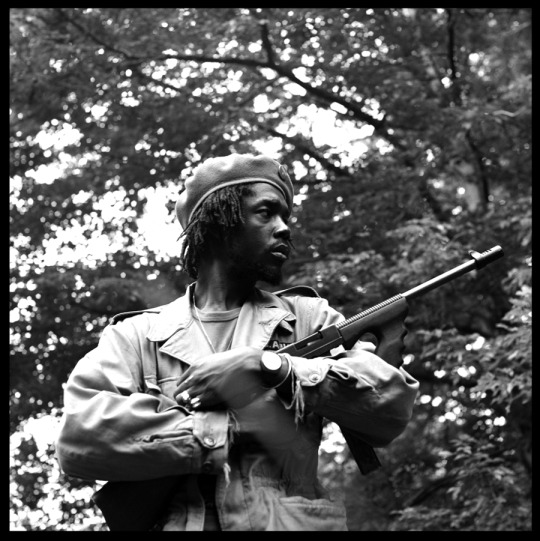
Peter Tosh, 1976. © Lee Jaffe
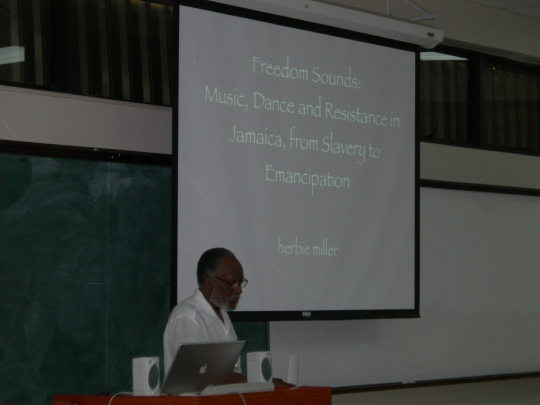
Herbie Miller giving a lecture at the ACS Crossroads Conference, July 2008. © JKD
© JKD, 27 November 2006, Kingston.
0 notes
Text
A WEEK IN NEW YORK WITH BRUCE AND BOB IN JULY 1973
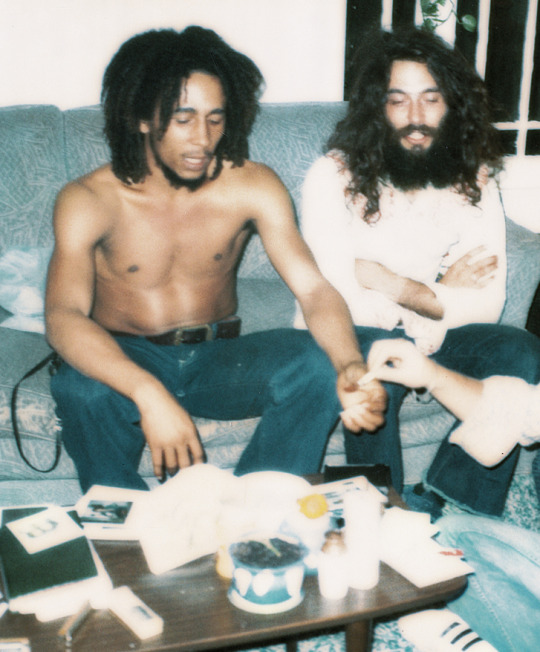
Lee Jaffe is an artist, photographer, filmmaker, musician and producer who, in July 1973, booked an unknown act from Jamaica to support an exciting new talent from New Jersey for a week long residency at New York's legendary Max's Kansas City. It kick started both performers on their paths to become cultural titans.
Lee recalls the week 50 years ago when each act alternated opening and closing slots for the 40 people who showed up each night, the two legends playing 14 gigs each across the week. Marley was making his first visit to America in support of the Catch a Fire album, while Bruce was promoting his first album. The two bands hung out - while also going to see The New York Dolls at Kenny's Castaways nightclub around the corner and Led Zeppelin at Madison Square Garden.
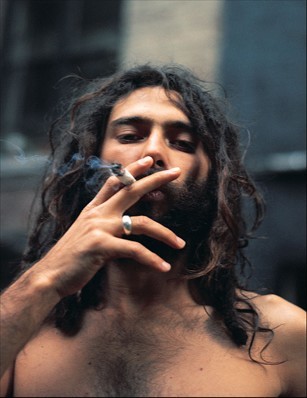
Lee tells the behind the scenes tales of this slice of rock history, joined by several contributors who were there - including Bruce Springsteen, Island Records founder Chris Blackwell, E Street band pianist David Sancious, photographer Bob Gruen, publicist Cherry Vanilla, manager Toby Mamis, Geoff MacCormack who went with David Bowie to see Bruce Springsteen, and Warhol acolyte Tony Zanetta who was a regular in the legendary back room at Max's.
This snapshot of a week in the life of one of New York's most acclaimed nightclubs of the 70s, where Andy Warhol held court every night with a stunning array of the art world's alternative elite, recalls the years when decadence was de rigueur among the hedonists who lived and breathed sex, drugs and rock 'n' roll.
The club's owner, Mickey Ruskin, prided himself on booking new bands who he believed had something different to offer - which is why Bob Marley and Bruce Springsteen were on the same bill that week in the summer of '73.
A Zinc Media production for BBC Radio 4.
This programme is available here (28 minutes).
Copyright BBC Radio 4.
Photos courtesy of Lee Jaffe.
#bob marley and the wailers#chris blackwell#reggae#max's kansas city#bruce springsteen#andy warhol#david bowie#island records#new york dolls#led zeppelin
3 notes
·
View notes
Text
INSIDE BOB MARLEY AND THE WAILERS 1973 1976
Bob Marley and the Wailers: 1973-1976 par Jérémie Kroubo Dagnini et Lee Jaffe (Camion Blanc, 2013, 298 pages).
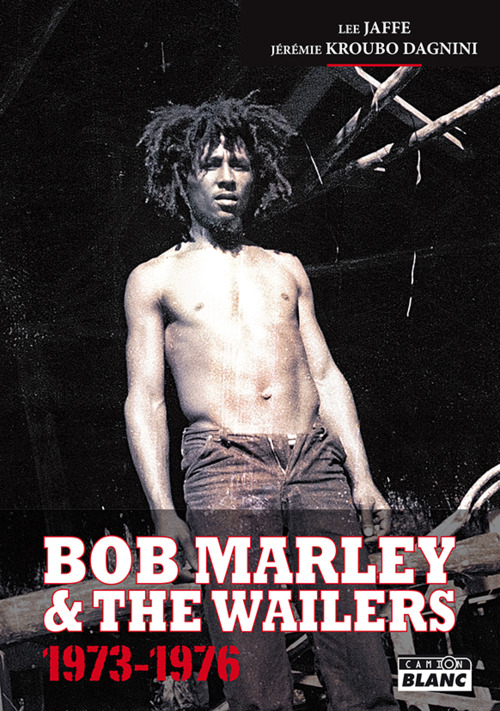

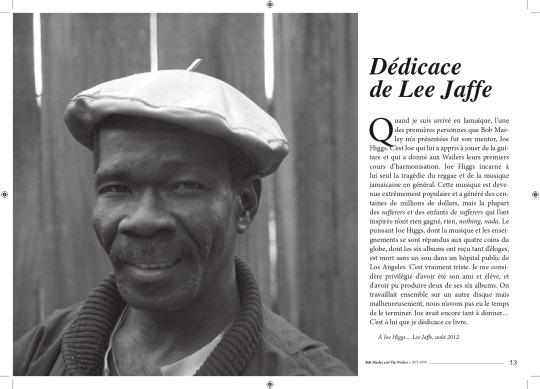
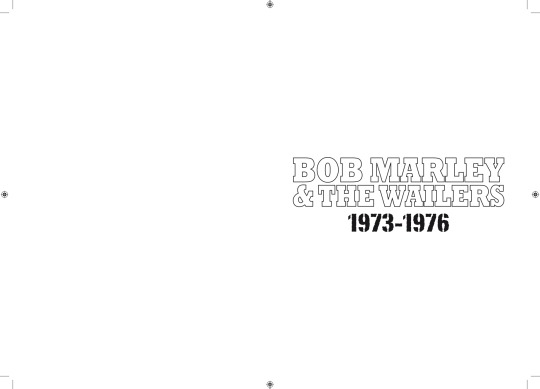
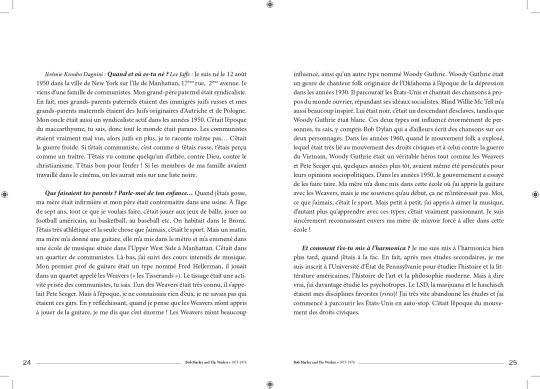
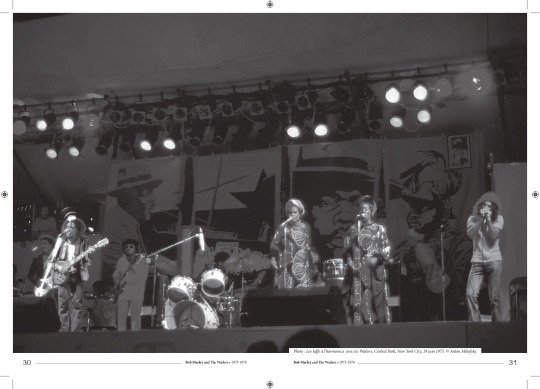
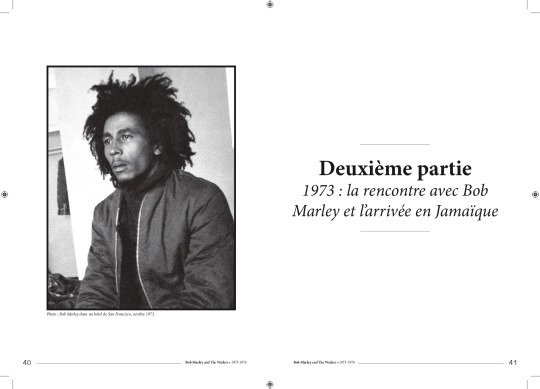


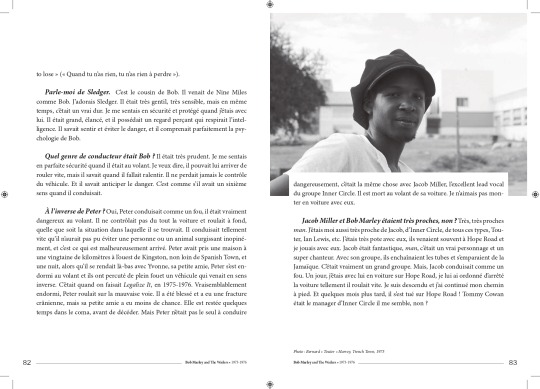
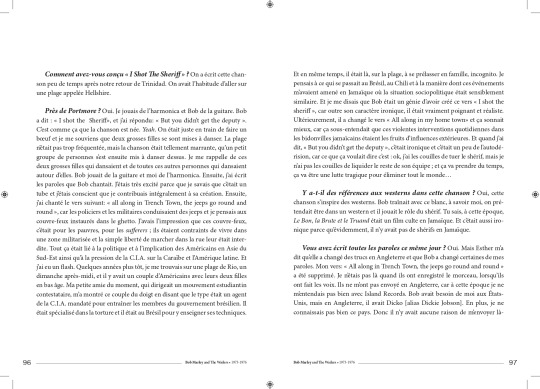

Pour plus d'infos, cliquez ici!
#bob marley and the wailers#bob marley#rita marley#lee scratch perry#peter tosh#reggae#ziggy marley#stephen marley
0 notes
Text
BOB MARLEY ONE LOVE review
No need to say too much to describe this movie directed by Reinaldo Marcus Green. One word is enough: WICKED!!!
Pas besoin de trop parler pour décrire le film réalisé par Reinaldo Marcus Green. Un seul mot suffit: WICKED!!!
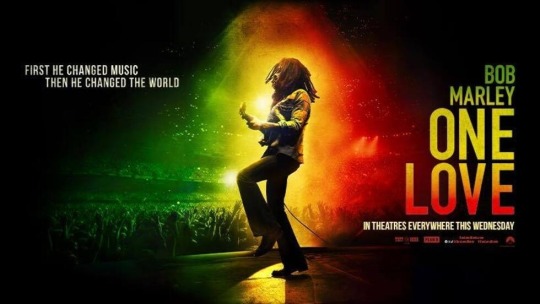
youtube
Par JKD.
#bob marley#ziggy marley#rita marley#tuff gong#reinaldo marcus green#kingsley ben adir#lee scratch perry#peter tosh#chris blackwell#Youtube
1 note
·
View note
Text
Quelques archives sur Bob Marley...
Toute cette effervescence autour du biopic sur Bob Marley (que je n’ai toujours pas vu d’ailleurs, mais ça ne saurait tarder !) m’a donné envie de trier mes archives sur le Gong… J’ai pris plaisir à retomber sur pas mal de documents intéressants, parmi lesquels vieux journaux, photos, cassettes vidéo, dvd, magazines etc… L'archivage "Marley" a encore de beaux jours devant lui. ONE LOVE! 🇯🇲 🇪🇹 🇯🇲 🇪🇹 🇯🇲 🇪🇹 🇯🇲 🇪🇹

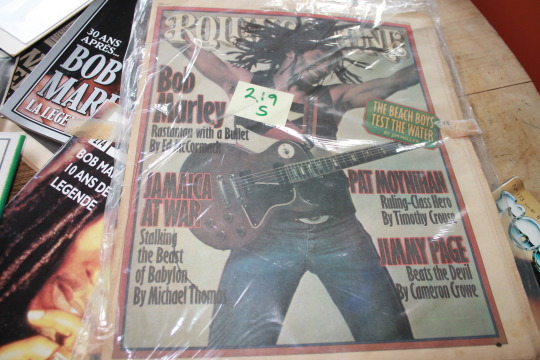


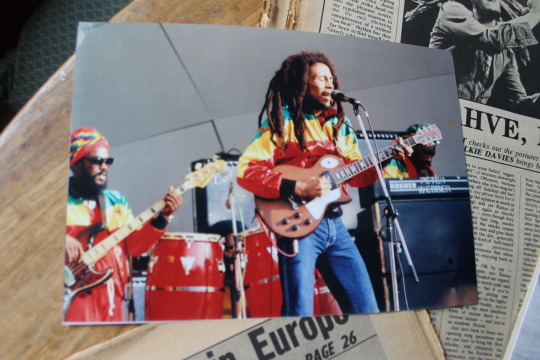
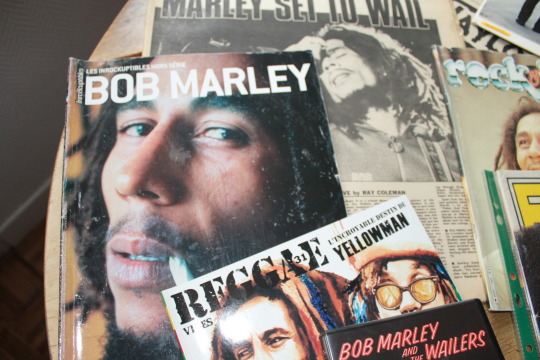
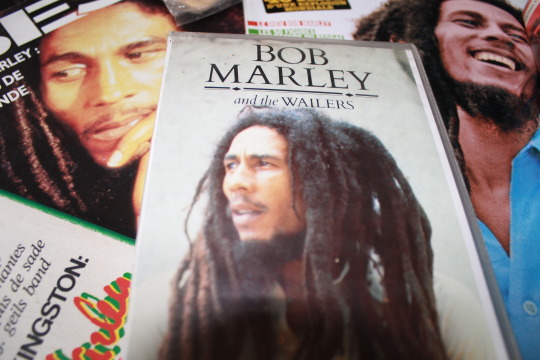
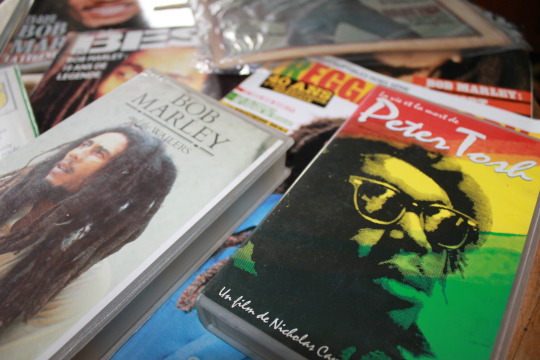
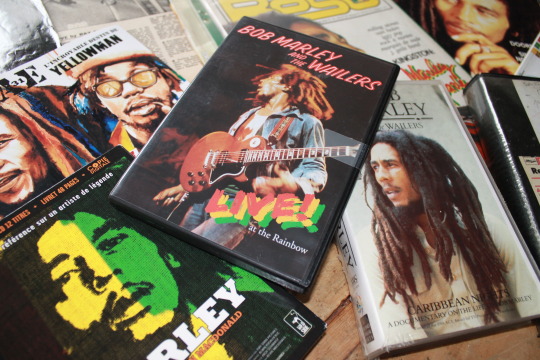

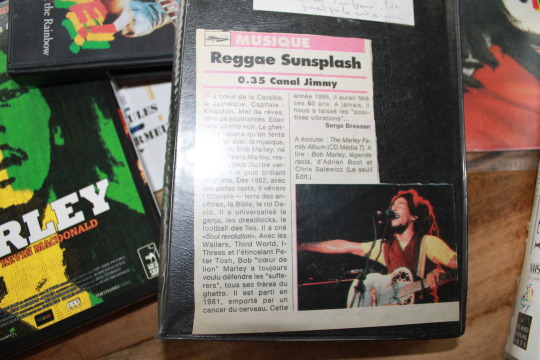
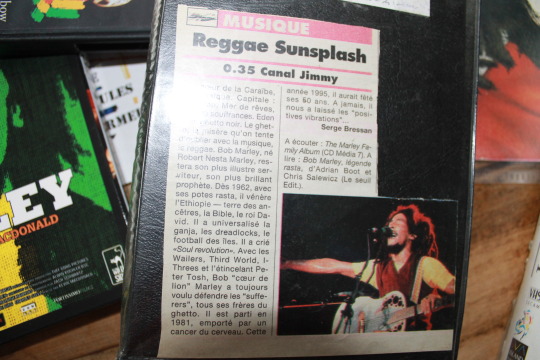
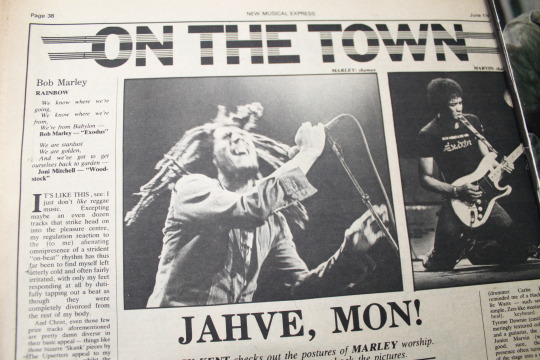
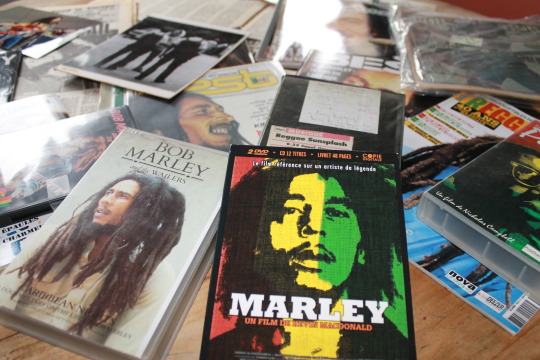
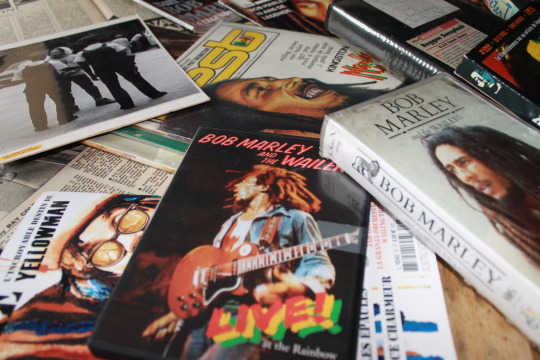
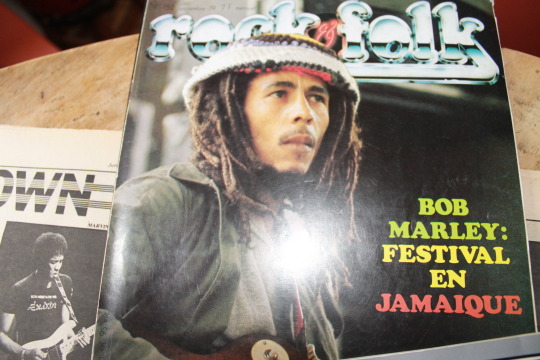

Pour les curieux et exigeants, à lire aussi Bob Marley & The Wailers: 1973 par Lee Jaffe et Jérémie Kroubo Dagnini (Camion Blanc, 2013, 298 pages).
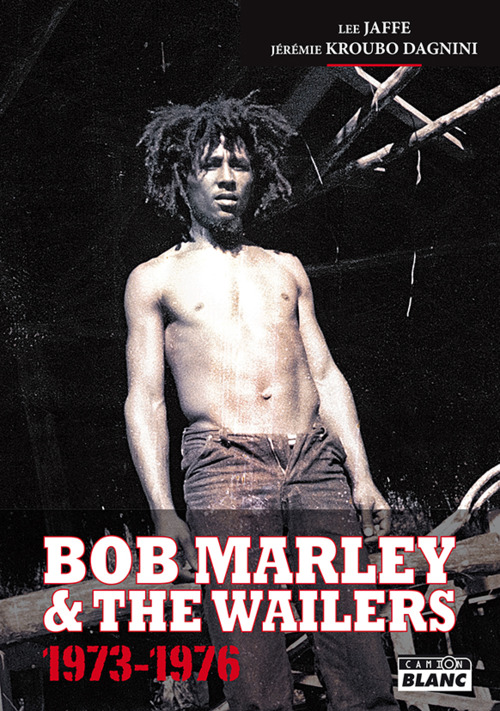


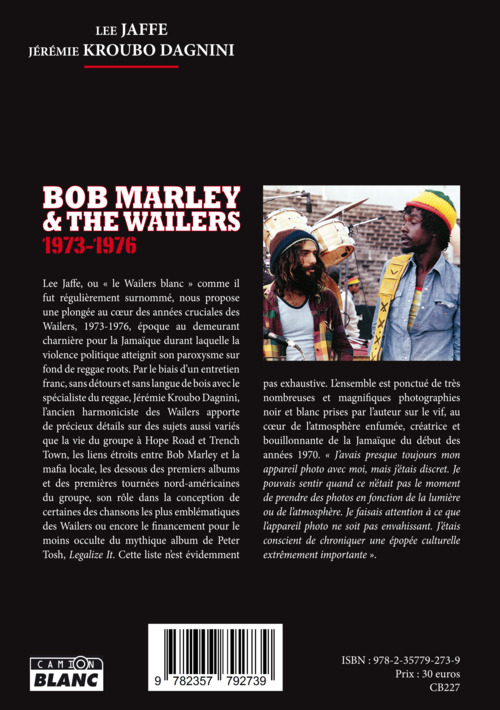
Interview de Lee Jaffe dans les Inrockuptibles (2-8 octobre 2013) par Francis Dordor: “Lee Jaffe, le Wailers blanc”. Il a vécu ses années les plus exaltantes dans l'ombre de Bob Marley….
youtube
1 note
·
View note
Text
Biopic Bob Marley One Love
Bob Marley: One Love. Un film réalisé par Reinaldo Marcus Green avec Kingsley Ben-Adir, Lashana Lynch, Michael Gandolfini... Dans les salles le 14 février 2024.
Pour les curieux et exigeants, à lire aussi Bob Marley & The Wailers: 1973 par Lee Jaffe et Jérémie Kroubo Dagnini (Camion Blanc, 2013, 298 pages).
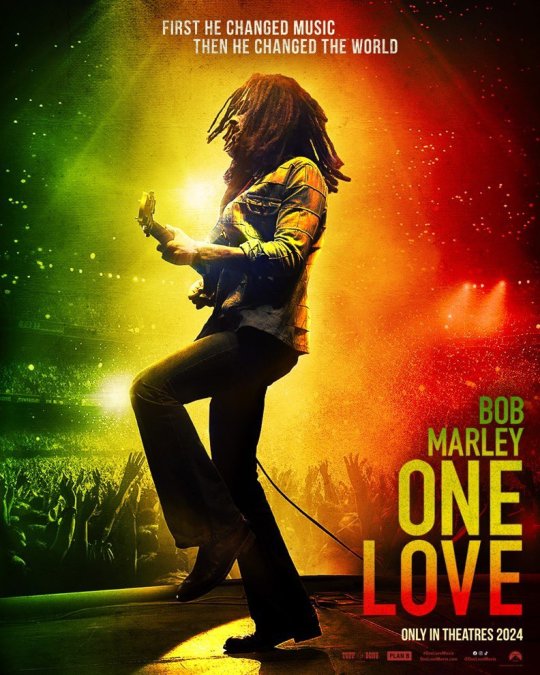

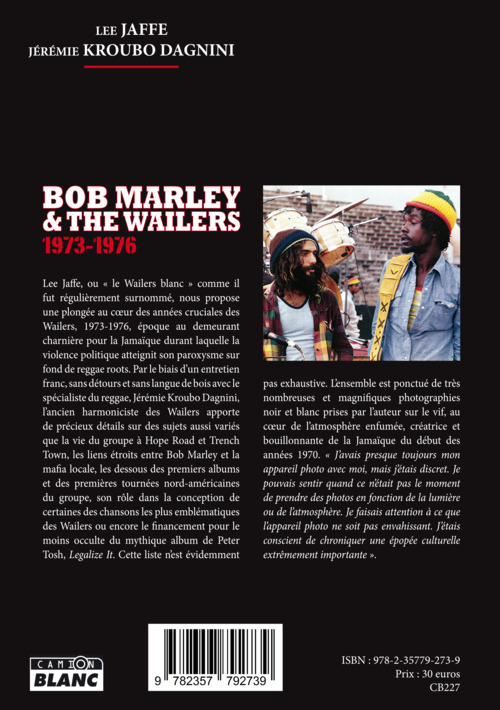
youtube
youtube
Interview de Lee Jaffe dans les Inrockuptibles par Francis Dordor: "Lee Jaffe, le Wailers blanc". Il a vécu ses années les plus exaltantes dans l'ombre de Bob Marley....
#bob marley#lee scratch perry#peter tosh#legalize it#bob marley and the wailers#reggae#rita marley#Youtube#stephen marley
0 notes
Text

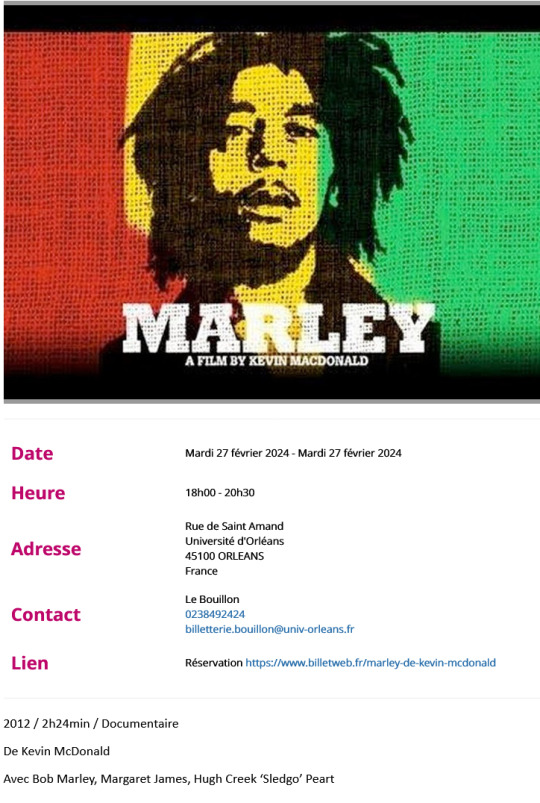

Le « Moment Reggae » organisé par l’Université d’Orléans : Exposition « 1970s Reggae Photos » (collection privée) du 5 février au 1er mars 2024 + Projection cinéma « Marley » de Kevin Macdonald le mardi 27 février 2024 à 18h au Bouillon !!! Deux événements entièrement gratuits !!
#lee scratch perry#adrian boot#reggae#jamaica#photography#collection#burning spear#peter tosh#linton kwesi johnson
0 notes
Text
L'ascension de Lee Perry dans le milieu de l'art contemporain
Un article fleuve écrit par JKD à lire en exclusivité sur reggae.fr!!! CLICK HERE!!!!
And the English, revised and expanded version is available here: "THE ROCKET-LIKE RISE OF LEE SCRATCH PERRY INTO THE CONTEMPORARY ART WORLD".
#lee scratch perry#contemporary art#adrian sherwood#par reggae.fr#outsider art#basquiat#jean michel basquiat#salvador dali#sun ra arkestra#george clinton#smithsonian#art#installation art#sculpture
1 note
·
View note
Text


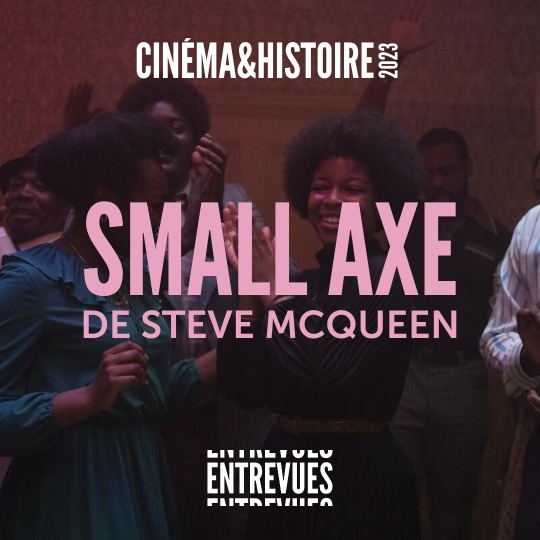
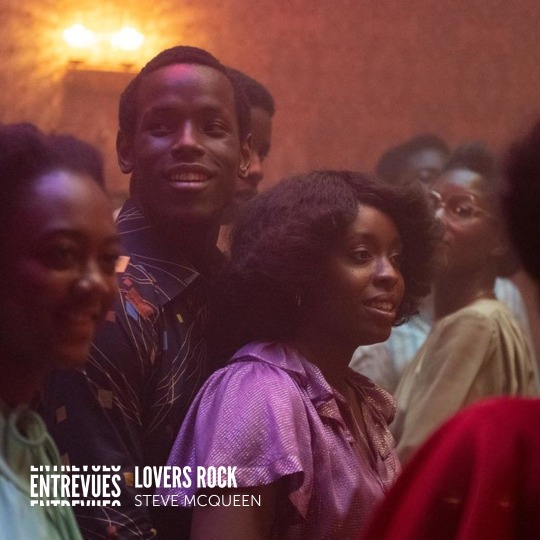
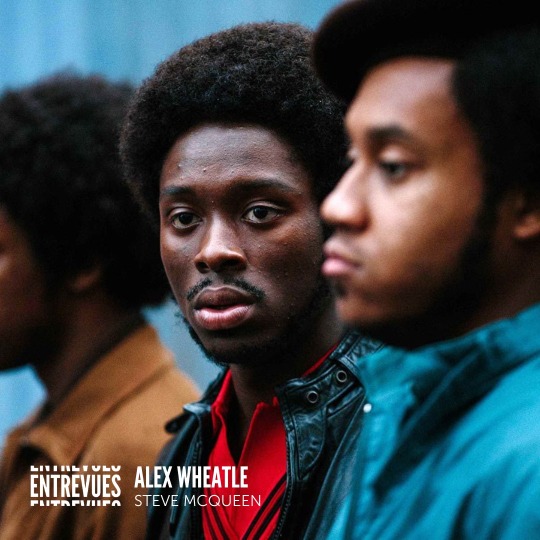
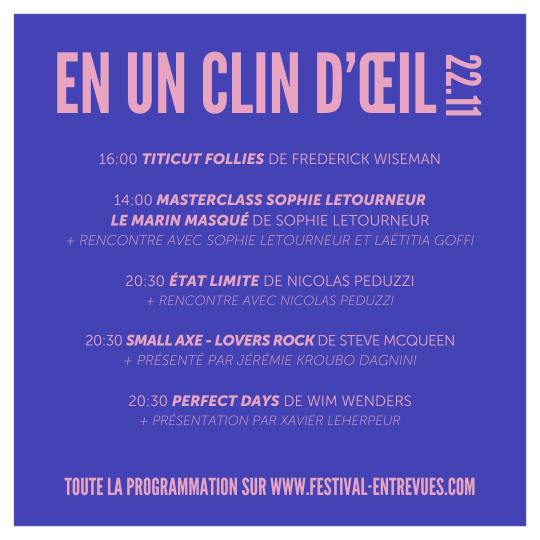
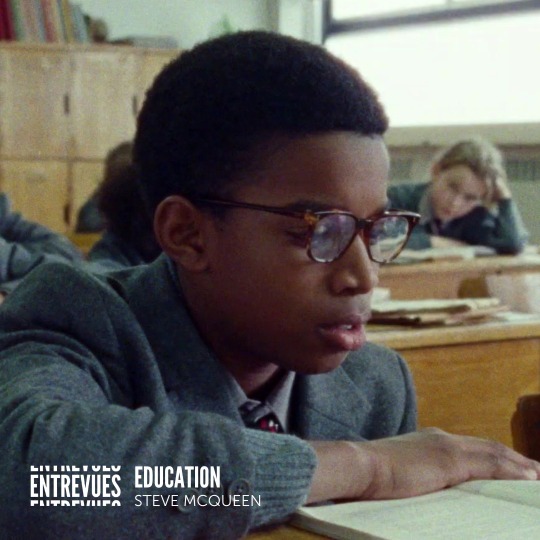


Présentation de la mini-série Small Axe de Steve McQueen au Festival international du film de Belfort - Entrevues (20-26 novembre 2023).
0 notes
Text
THE ROCKET-LIKE RISE OF LEE SCRATCH PERRY INTO THE CONTEMPORARY ART WORLD

© Reggae.fr / On The Roots Kevin Buret - 2016.
Lee Perry: A Pop Artist
Altogether dancer, singer, musician, producer, eccentric, visionary, shaman and genius, Lee “Scratch” Perry is to Jamaican music, some would say, what Sun Ra is to free jazz, George Clinton to funk or Salvador Dali to painting. Born in 1936, in the small town of Kendal in Jamaica, Lee “Scratch” Perry participated in a concrete way in each of the important stages of the history of Jamaican music. A true pillar of reggae and dub, his innovations have left their mark on many other musical genres around the world, including: US rap; UK punk, jungle, ambient and trip-hop; Japanese electronic music; without forgetting European techno and avant-garde music. Today, Lee Perry is no longer of this world, in the flesh at least. He died late August 2021 at the age of 85. Nevertheless, his name unquestionably stays in vogue. It is still on the lips of pop stars like the Rolling Stones, The Orb, The Roots and Major Lazer, and we can also gradually hear it spreading in the contemporary art world.
The Black Ark: Sound and Image
Lee Perry always evolved into a very personal visual universe, starting with his legendary home recording studio, the Black Ark, at the origin of the most innovative sounds of the second half of the 1970s in Jamaica. Originally thought to be a sort of sanctuary for Rastafarians, the Black Ark was a very confusing place, whose walls were covered in cryptic inscriptions and floors served as dumping grounds for installations and other DIY projects, all of them being zanier than the next – a sculpture was even embedded inside one of the walls, says his ex-wife, Pauline Morrison, in People Funny Boy written by David Katz (2000: 324).
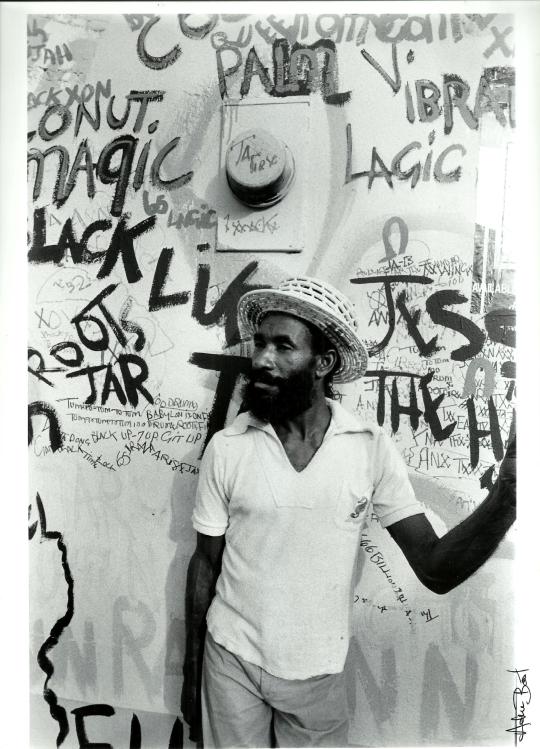
© Adrian Boot, circa 1977/ 1979. Part of JKD’s private photo collection.
This Baroque environment was part of the eccentric personality of the genius producer, embodied in an increasingly extravagant look and outfits over the ages: during his final years, he used to dye his hair and beard yellow, green of even pink, and he was decked out in completely fantastical clothes, personalised with pins and other fanciful objects. And when he was not wearing his famous golden baseball cap, adorned with glittering CDs, badges or religious illustrations, he was wearing a Native American feathered war bonnet or a wizard hat.

© Lee Scratch Perry painting in his studio in Switzerland (Blue Ark), 2018. Photo: Lorenzo Bernet. Courtesy: The Visual Estate of Lee Scratch Perry / suns.works.

© Lee Scratch Perry wearing his wizard hat in his studio in Switzerland (Blue Ark), 2019. Photo: Lorenzo Bernet. Courtesy: The Visual Estate of Lee Scratch Perry / suns.works.
It is more than clear Lee “Scratch” Perry was an artist with a capital A, a complete, total, full-time artist who did not switch to Rainford Hugh Perry (his real name) in private and who did not lock himself into a single box: the one of music. He did not play a role, he lived through his art full-time and was attracted as much to sounds as to visuals. Indeed, the latter played a significant role in his galaxy, in his symbolism, in his perception of the world. According to Perry himself, the image was the preferred channel for conveying messages (often subliminal), it was therefore necessary for him to be wary of them and to be able to reappropriate them. In some way, it can enable us to understand his involvement (conscious or unconscious) in the visual arts, which by the way was not recent. Indeed, reading his brilliant biography written by David Katz, we can easily realize that Perry had always been interested in his physical and cultural environment, the objects that surrounded him as well as the pop culture into which he loved to dig.
Even in the late 1950s, long before he began his musical career, when he worked in construction in Negril and drove bulldozers, Perry focused his attention on the noises associated with construction work and the energies of machines as they came into conflict with nature, one can read in People Funny Boy. He even reported an almost supernatural experience, resulting in his departure from this seaside resort located at the far western part of Jamaica to the capital Kingston in the early 1960s: “I get an overload from throwing stones down there for maybe two weeks. I started making positive connection with stones, by throwing stones to stones I start to hear sounds. When the stones clash I hear the thunder clash, and I hear lightening flash, and I hear words, and I don’t know where the words them coming from. These words send me to King-stone: to Kingston” (2000: 8).
Until the end of his life, stones occupied a pre-eminent place in his resolutely mystical universe. He regularly collected them, piled them up, carried them to various places, and even cooked them in a pot on the fire. In the late 1970s, that is precisely what happened, says Pauline Morrison, in their home in Washington Gardens, Kingston, which also housed his legendary recording studio.
“Pauline has claimed she was preparing a meal one afternoon when she noticed an odd smell coming from the kitchen. When she checked the pot, she found that Scratch had emptied the simmering contents into the mud of the yard, substituting a pan full of rocks in their place on the fire” (2000: 324). “If you see our house, this guy write all kind of shit on the wall, on the fence…” (2000: 323). And the Jamaican singer, Vicky Nelson, added, “my foot would be in paint, I would get rocks and all those nature things” (2000: 345).
As Pauline Morrison and Vicky Nelson suggest, Lee Perry also paid a great importance to writing and painting at the time of Black Ark. We must indeed go back very far in time to understand the links he developed with the visual arts and everything encompassed by this generic term: calligraphy, graffiti, assemblages, collages, installations, and painting among others. In short, everything that would make up his artistic inventory alongside his music. Lee “Scratch” Perry had always been a compulsive sketcher and graffiti artist, feeling a certain need to fill, if not to say overload, empty surfaces. From the end of the 1970s onwards, he even seemed to pay as much attention to the decoration of his studio as to musical production at times.
"Jean-Michel Basquiat himself called him a significant source of inspiration for his paintings"
Moreover, it is not surprising that at that time Lee Perry also commissioned art from Rastafarian artist Jah Wise to decorate the Black Ark. Indeed, he had the walls surrounding the studio decorated with huge, multicoloured murals painted by Robert Van Campbell aka Jah Wise. A portrait of Haile Selassie was placed just above the door so that all would have to ‘bow’ to Jah upon entering or leaving; to the left of his head was Selassie in his feline form as the Conquering Lion of Judah. Another wall had a life-size mural of the Super Ape, tree and spliff in hand, while the inside of the studio depicted African ancestors in chains and Rastafarian tri-colour flags. As time passed, such images would be altered and re-cast as Perry sought to express different concepts; like the music that was coming from inside the studio, its illustrated walls would seldom remain static. He also erected a sign with a ‘Management Order’ by the front gate, proclaiming that the premises included the site of a private house where women and children lived; all who sought to enter were to wait for official permission and once inside, were to refrain from using indecent language. (In People Funny Boy, French edition, 2012: 476-477).
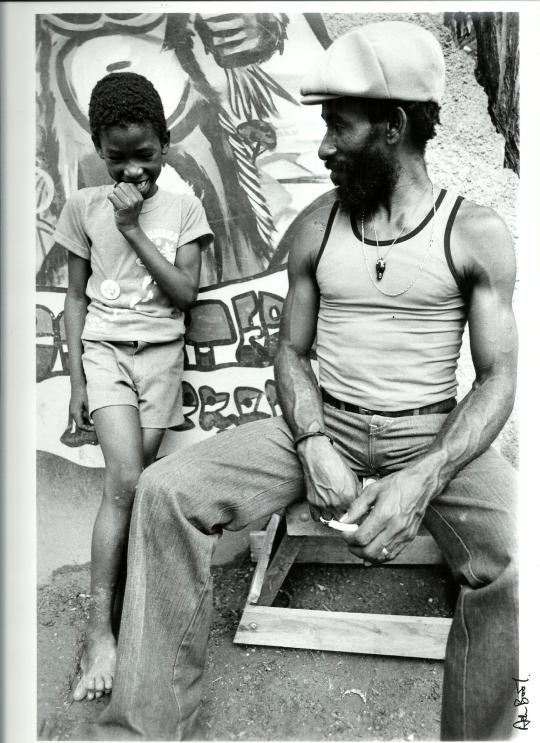
© Adrian Boot, 1978. Lee Perry and his son, Mark (aka Omar), at the Black Ark. In the background there is a glimpse of the “Super Ape” painting done by Jah Wise. Part of JKD’s private photo collection.
youtube
Lee “Scratch” Perry outside Black Ark Studios, Jamaica, 1977, premium footage from the Don Letts Archive available on YouTube.
All things considered, Lee Perry’s artistic source of creation originated far away back in time and widely developed during the seething cultural period of the Black Ark. Back in the 1970s, Lee Perry was already considering himself as a multi-disciplinary Artist and was already in contact with avant-garde people not only from Jamaica but also from England (Don Letts, John Lydon from the Sex Pistols, The Clash etc.).
After the Black Ark was destroyed by fire on one morning in the summer of 1983, Lee Perry experienced a very long period of exile, first in England, then in Switzerland where he moved out at the end of the 1980s with his new and last wife, a sultry queen of the Zurich nightlife, born Mireille Ruegg, only daughter of a couple of Swiss restaurateurs, who would become his manager. It was then that he started to show more and more interest in art, in a more professional way shall we say, the collections of four-handed paintings executed with British visual artist, Peter Harris, first between 2007 and 2009, then between 2014 and 2015, constituting a very good illustration of the extent of his pictorial work.
The Meeting with British Visual Artist Peter Harris
“How does a 40-year-old white British artist meet up with a 70-year-old black shaman from Jamaica and make a real connection? I am not a Rastafarian black man from the ghettos of Trench Town, I am a lower middle class Catholic son of an absent submariner father who moved from place to place and, as a consequence, has no ‘roots’ to speak of. This has led to a lifetime of what I suspect will be an unachievable search for home. I have lived through a series of popular culture ‘father figures’ who have been inspirational guides such as Bob Dylan, Francis Bacon, Johnny Rotten and Picasso, and Lee is one I’ve been lucky enough to meet in person. […] Lee’s experience and understanding - or “overstanding” - of Babylon is very different to my version of it. Lee’s version of Babylon might come from the Rasta’s view of western society as being corrupt, a world of ‘politricks’ and oppressors of Rastafarians. My version of Babylon is also about a society that oppresses our lives, but it is more about the unrelenting trajectory of existence. It might go something like this: birth, school, dreams, peer pressure, music, drugs for fun, student loans, love, jobs, depression, pressure, holidays, insecurity, mortgage, drugs for escaping, children, stress, peer pressure, cars, responsibilities, doubts, reality, panic attacks, bills, new clothes. In it but not of it, pets, vet bills, gym, mid-life crisis, new haircuts, hair loss, beer bellies, guilt, cigarettes, alcohol, food, cancer, medicine, pensions, fear, death” (interview conducted with Peter Harris by JKD, 2014).
In February 2005, Lee “Scratch” Perry responded positively to a request from Peter Harris who wanted him to be in a film he was working on, called Higher Powers. “I wanted different sorts of people who represented different kinds of higher powers,” Harris explains, “almost archetypal people. It might be a powerful gangster outside the law or a police chief, to someone with a spiritual higher power, or someone who totally doesn’t believe in higher powers. For the creative higher powers, or the visionary people, I thought of Ken Russell and Lee Perry” (2012: 898).
The concept was an appealing one for Perry, so permission was granted for Harris to film him at home on February 14th. The British visual artist interviewed him on various themes such as: destiny, faith, redemption, luck, love, doubt, etc. He then returned to London to edit the results. Subsequently, Peter Harris planned further filming sessions with Perry for the same film project. On October 1, 2007, Peter Harris' film, Higher Powers, was screened for the first time at the Lüneburg Art Hall in Germany. Perry appeared in the company of such controversial personalities as former gangster Dave Courtney, gay rights activist Peter Tatchell, Conservative politician Boris Johnson, Reverend Joanna Jepson (who has campaigned against the use of abortion for “eugenic reasons”), paranormal spoon-bender Uri Geller, Tibetan Buddhist monk Akong Tulku Rinpoche, and conspiracy theorist David Icke (2012: 910). Some years earlier, Harris had approached performers such as David Bowie, Siouxsie Sioux and members of the Stranglers, for ideas that he could turn into paintings; with a similar concept in mind, Harris returned to Switzerland in November 2007 to make a series of collaborative drawings with Lee Perry, ultimately inducting Perry into the world of fine arts.
“I’d done a Self-Portraits by Proxy series before,” Harris explains, “in which every person who had affected my life and influenced me, I asked for an idea, and then made that idea into a painting, but with Lee, it was a bit different. I called him up and said, ‘I’ve got these themes from the film, and I want you to give me the first image that comes into your head’; I’d say, ‘Luck,’ or whatever, and he would come up with some mad image, and I’d make it a drawing. Then I took all the drawings to his place in Switzerland, and he said we should cut them up; he was remixing them, like a record, taking something from one drawing and placing it with another, and it was more like a ceremony, or an Obeah ritual, so he spent a lot of time trying on different hats and costumes, as if he was getting into character. We started work at seven, and worked right through till four in the morning, and he had one CD that was just on repeat the whole time” (2012: 911).
On September 10th, Perry performed a special live dub set at London’s Tabernacle, with Adrian Sherwood at the mixing desk and live video animation behind him, as the climax of the “Higher Powers” art exhibition arranged by Peter Harris, which showcased the drawings the pair had produced in 2007, as well as a number of collaborative paintings they made together in Switzerland on August 15th 2009. The artwork dealt with typical Perry themes, such as social injustice, religious dogma, the unequal distribution of wealth, sex, and personal vengeance; some of the paintings bore the man’s handprints and footprints as well, while both paintings and drawings were marked by Perry’s declamatory graffiti (2012: 920). Images of the painting sessions carried out jointly by Peter Harris and Lee Perry in 2007 and 2009 as well as footages from the Tabernacle exhibition are viewable in the documentary, Lee Scratch Perry's Vision of Paradise, directed by Volker Schaner in 2015, an excellent film which also retraces the unusual trajectory of Lee Perry and clearly reflects the great part that art played in his daily life.
youtube
Lee Scratch Perry’s Vision of Paradise by Volker Schaner.
And as for the hundred works of art that the two artists made together between 2014 and 2015, they draw their inspiration from the Bible, from the Book of Revelation in particular.“With its tales of evil deeds, redemption and the apocalypse. It is rich in imagery, metaphor and parables. A parable is not a literal thing. It would not make sense to our modern minds, informed by readily available facts, to take it so. Language and visual language are vehicles for getting at some ‘truth’ as truth is often inexpressible” (interview conducted with Peter Harris by JKD, 2014).
This meeting with Peter Harris was clearly a step forward for Lee Perry into the world of contemporary art.

“Ja Pay” © Peter Harris and Lee “Scratch” Perry, biro pen and permanent marker pen on paper, 42 x 42 cm, 2007.
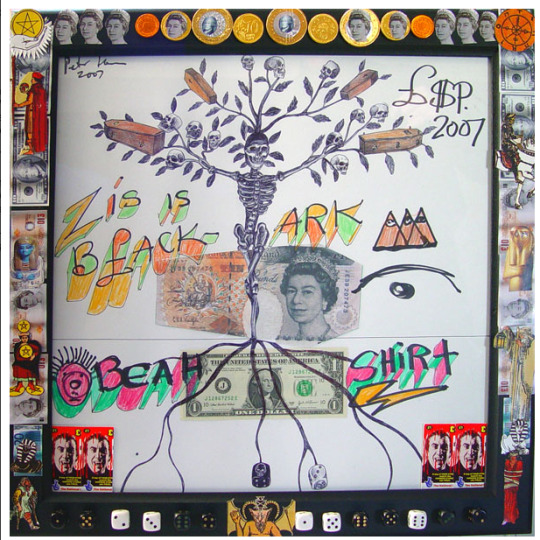
“Zis Is Black Ark” © Peter Harris and Lee “Scratch” Perry, collage, biro and pencil on paper, 42 x 42 cm, 2007.

“Judgement Com Yow” © Peter Harris and Lee “Scratch” Perry, marker pen, oil, acrylic paint on canvas, 123 x 109 cm, 2009.

“Super Ape” © Peter Harris and Lee “Scratch” Perry, biro pen, marker pen, felt tip and gold leaf paint on paper, 30 x 42 cm, 2014-2015.

“Super Man in Space” © Peter Harris and Lee “Scratch” Perry, biro pen, marker pen, felt tip and gold leaf paint on paper, 30 x 42 cm, 2014-2015.
The Rise of Lee Perry into the Contemporary Art World
A contemporary artist status confirmed by his induction into the Pantheon of sculptures made by Xavier Veilhan - using a 3D scanner - and held simultaneously in New York and Paris in the spring of 2015. During this double exhibition organised around music and simply named “Music”, the French visual artist wanted to pay tribute to the great music producers who had been shaping the soundtrack of our time, including Philippe Zdar, Pharrell Williams, Quincy Jones, Daft Punk, Rick Rubin, Brian Eno and Lee “Scratch” Perry. The latter therefore appeared in this impressive list of geniuses (around twenty in total), whose collectors are now snapping up statues made from a range of varied materials (from wood to metal through polyurethane resin).

“Lee Scratch Perry”, © Xavier Veilhan, “Music” exhibition, aluminium-filled polyurethane resin, plywood, acrylic paint, varnish, 122,5 x 62 x 86 cm, 2015.
What followed was a portrait (on paper this time) dedicated to him by the monthly art French magazine, Beaux-Arts, in 2017, on the occasion of the exhibition “Jamaica Jamaica!” held at the Paris Philharmonic (April 4-August 13, 2017), where the above-mentioned statue created by Xavier Veilhan was moreover exhibited.

© article published on 23 May 2017 by Magali Lesauvage in Beaux-Arts.
Lee Perry made the front cover of other art magazines, such as the Italian biannual, Kaleidoscope, in 2020-2021.

© Kaleidoscope, number 37, 2020-2021.
Finally, alongside all this, Lee Perry's visual artworks have been the subjects of numerous personal and group exhibitions around the world, starting with his very first solo exhibition held at the Californian gallery Dem Passwords from November 13 to December 11, 2010 under the name “Secret Education”.

© Dem Passwords, « Secret Education » exhibition, 2010.
Three other solo exhibitions were organised by this same gallery in 2013 (“Repent Americans” from April 20 to June 15), 2014 (“The Death of Baphomet” from August 29 to October 11) and 2016 (“Judgment Repentance God Order” from June 16 to July 30).
"these many art exhibitions around the world have coincided with the new curatorial team responsible for the visual estate of Lee “Scratch” Perry and headed by Lorenzo Bernet (...) this new, fresh and dynamic curatorial team seems to come up with creative and innovative ideas"
In that same year, Lee Perry also did an art show in New York, from June 29 to July 29, 2016 as part of a collective exhibition entitled “A Being in the World” and held at Salon 94 on the lower east side of Manhattan. His pieces of work were thus exhibited alongside those of a very heterogeneous panel of artists, including the African-American self-taught artist and former slave, Bill Traylor (1854-1949), and Maia Ruth Lee (born in 1983 in South Korea).

© Dem Passwords, « Judgement Repentance God Order » exhibition, 2016.
Then, Lee Perry multiplied international shows: at the Swiss Institute in New York in 2019, at the 2021 São Paulo Bienal, at the Museum of Contemporary Art of Rome in 2022, and at the Cabinet Gallery in London as well as at the 2023 Art Cologne international art fair, just to name a few. In total, Lee Perry actively took part in no less than fifteen international exhibitions between 2016 and 2023, and almost half of them in the last couple of years, which is the guarantee of a rocket-like rise on the contemporary art scene. Regarding this latter point, it is crucial to emphasize that these many art exhibitions around the world have coincided with the new curatorial team responsible for the visual estate of Lee “Scratch” Perry and headed by Lorenzo Bernet, a Zurich-based gallerist, curator and art dealer who is also the man behind the suns.works gallery. Therefore, it might be no exaggeration to say that this art world rocket rise relates to this new, fresh and dynamic curatorial team that seems to come up with creative and innovative ideas.

“Flood Sun” © Lee Scratch Perry, collage, markers and acrylic on wooden board, 60 x 100 cm, 2020. Courtesy: The Visual Estate of Lee Scratch Perry / suns.works.

“Genesis” © Lee Scratch Perry, collage and acrylic on paper, 70 x 50 cm, 2020. Courtesy: The Visual Estate of Lee Scratch Perry / suns.works.

“Pisces and Aries (Yin Yang)” © Lee Scratch Perry, collage and acrylic on canvas, 170 x 140 cm, 2020. Courtesy: The Visual Estate of Lee Scratch Perry / suns.works.
It is also important to underline the presence of some of his drawings, paintings, collages and other installations in the collections of art aficionados like Sir Raymond Douglas Davies aka Ray Davies (former songwriter and lead vocalist for the legendary British rock band the Kinks), English record producer Adrian Sherwood (Coldcut, Depeche Mode, Primal Scream, Sinéad O'Connor, Lee “Scratch” Perry, Dennis Bovell), Mexican producer, remixer and composer Camilo Lara, and the British artist couple formed by Tim Noble and Sue Webster, as well as prestigious institutions such as the Bonnefanten Museum in Maastricht (NL). Others should soon be included in the permanent collections of the National Gallery of Jamaica as well as the Smithsonian Institution in Washington which currently investigates, along with the National Museum of African American History and Culture, Afrofuturist expression through art, music, and activism among others: an exhibition (March 23, 2023 – August 18, 2024) in which Lee “Scratch” Perry appears next to avant-garde jazz legend Sun Ra and the leader of African American Funkadelic style George Clinton - the threesome being tied to raw, original and pioneering Black aesthetic forms. And again, one owes this real tour de force to the new curatorial team headed by Lorenzo Bernet!

“Blue Ark (studio view)” © Lee Scratch Perry, 2016-2021. Photo: Camille Spiller. Courtesy: The Visual Estate of Lee Scratch Perry / suns.works.

“Blue Ark with TV Sculpture (studio view)” © Lee Scratch Perry, 2016-2021. Photo: Camille Spiller. Courtesy: The Visual Estate of Lee Scratch Perry / suns.works.

“Blue Ark (studio view)” © Lee Scratch Perry, 2016-2021. Photo: Claude Barrault. Courtesy: The Visual Estate of Lee Scratch Perry / suns.works.
Last but not least, the resale of some of his artworks at auctions needs to be mentioned too, let alone the fact that Jean-Michel Basquiat himself called him a significant source of inspiration for his paintings, according to multi-disciplinary artist Lee Jaffe as well as the Gagosian Quarterly (Winter 2021 Issue).
A whole set of signals which suggests a more than bright future for Lee “Scratch” Perry in the modern and contemporary art world.

“Vanity Struck Me in My Tooth”, © Lee Jaffe in collaboration with Jean-Michel Basquiat, acrylic on Cibachrome print, 203 x 122 cm, 1983.

“Avenge” © Peter Harris and Lee “Scratch” Perry, marker pen, oil, acrylic paint on canvas, 124 x 95 cm, 2009. This work of art has been bought by Adrian Sherwood; it can be seen in the video below shot in 2022 in the deck-out living room of the producer.
youtube
Horace Andy : Tiny Desk (Home) Concert.
Books :
People Funny Boy: The Genius of Lee “Scratch” Perry, David Katz, 2000, Canongate Books, 538 pages.
Lee “Scratch” Perry: People Funny Boy, David Katz, 2012, Camion Blanc, 990 pages (French edition).
People Funny Boy: The Genius of Lee “Scratch” Perry, David Katz, 2021, Orion Publishing Group Limited, 688 pages (revised and expanded English edition).
Lee Scratch Perry: Black Ark, Andreas Koller & Lorenzo Bernet (Ed.), publication expected in July 2024, Edition Patrick Fey, 600 pages (500 illustrations).
Films :
Lee Scratch Perry’s Vision of Paradise, Volker Schaner, 2015, 100 min.
This article is the English, revised and expanded version of my paper published on Reggae.fr on 30 November 2023. © Jérémie Kroubo Dagnini (JKD).
#lee scratch perry#contemporary art#adrian sherwood#par reggae.fr#reggae#art#Youtube#art museum#collage art#installation art#jamaica#ray davies#the kinks#gagosian#basquiat#afrofuturism#afrofuturistic#artwork#drawings#installation#outside art#smithsonian#salvador dali#sun ra arkestra#george clinton
1 note
·
View note
Text
SMALL AXE de STEVE MCQUEEN au Festival du Film de Belfort - ENTREVUES
Cinéma et Histoire
Small Axe de Steve McQueen

« Small Axe » est à l’origine le titre d’une chanson de Bob Marley, produite et enregistrée en 1970 par Lee « Scratch » Perry, pionnier du reggae et du dub. Elle contient une double lecture, dénonçant d’une part le monopole du marché du disque jamaïcain par les trois grands producteurs de l’époque et d’autre part, la domination des puissants sur les opprimés.
C’est une métaphore sur la manière dont la petite hache (« small axe ») peut abattre un grand arbre robuste et oppressif. Chanté pour donner confiance aux exclus dans leur combat pour la justice sociale, ce morceau est en définitive une allégorie de cette collection de films éponyme réalisée par Steve McQueen, premier cinéaste noir oscarisé pour son film, Twelve Years a Slave (2014). Né à Londres en 1969 de parents originaires des Petites Antilles, le réalisateur voulait depuis longtemps proposer une visibilité pour sa communauté, dont le récit a trop souvent été occulté du cinéma britannique. C’est donc chose faite avec ces cinq films indépendants qui explorent l’histoire tourmentée des Afro-Caribéens dans l’Angleterre des années 1960-80, dressant un portrait relativement exhaustif et nuancé du racisme endémique qui gangrénait les différentes sphères sociétales : l’emploi, le logement, la police, la justice pénale, l’éducation ou encore les relations sociales. Le tout chapeauté en filigrane par une monarchie aussi impassible qu’immuable, représentée par cette photo de la reine Elisabeth II qui surplombe à plusieurs reprises les institutions que traversent les personnages. À ce propos, certains sont réels, d’autres fictifs, mais là encore, le ton est toujours direct, juste et éloigné des clichés. Et un troisième type de personnages s’invite dans cette mini-série, la musique : omniprésente, chaude, envoûtante, sensuelle, hypnotique et incontestablement noire, synonyme alternativement, parfois simultanément, de divertissement, de refuge, d’exutoire, de résistance et de révolte. C’est le battement de cœur de Small Axe. Le meilleur du calypso, du reggae, du dub et de la soul rythme ainsi tambour battant cette anthologie en cinq actes, à regarder et à écouter sans modération ...
JÉRÉMIE KROUBO DAGNINI
Un cycle accompagné par Laurence Reymond (programmatrice), Jérémie Kroudo Dagnini (spécialiste des musiques populaires jamaïcaines) et Léna Momène.
Pour plus d'infos: https://www.festival-entrevues.com/fr/retrospectives/2023/small-axe-de-steve-mcqueen
0 notes